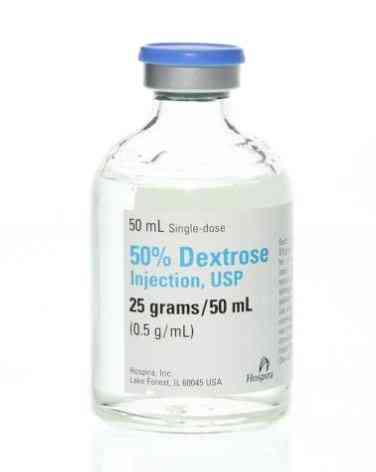
50% w/v DEXTROSE INTRAVENOUS INFUSION B.P. Price
Active Substance: Dextrose.
Overview
Welcome to Dwaey, specifically on 50% w/v DEXTROSE INTRAVENOUS INFUSION B.P. page.
This medicine contains an important and useful components, as it consists of
Dextroseis available in the market in concentration
Name
Dextrose
Precaution
Diabetes mellitus or impaired glucose tolerance Renal impairment, due to risk of fluid overload or electrolyte imbalance Congestive heart failure or conditions predisposing to fluid retention Cerebral edema, as hypotonic solutions may worsen intracranial pressure Monitor blood glucose levels, especially in patients on insulin or other hypoglycemics. In neonates, rapid infusions can lead to hyperglycemia or fluid overload. Avoid prolonged use without appropriate electrolytes (can cause dilutional effects). Ensure aseptic technique when using injectable forms to avoid infections.
Indication
Hypoglycemia (low blood sugar) Dehydration, particularly with glucose-electrolyte imbalances Nutritional support in total parenteral nutrition (TPN) Diluent for IV medications Emergency energy source in unconscious or fasting patients Ketosis prevention in patients unable to eat
Contra indication
Known hypersensitivity to dextrose or corn products Hyperglycemia or uncontrolled diabetes Anuria (complete kidney failure) or severe renal impairment without dialysis Intracranial or intraspinal hemorrhage, due to fluid shift risks Delirium tremens with dehydration Hypokalemia or hyponatremia, unless supplemented with appropriate electrolytes
Side Effect
Hyperglycemia, especially in diabetic or insulin-sensitive patients Fluid overload or pulmonary edema, particularly with excessive or rapid IV infusion Electrolyte disturbances (hypokalemia, hyponatremia) if not supplemented properly Phlebitis or vein irritation at infusion site Rarely: hypersensitivity reactions (rash, fever, or anaphylaxis) Osmotic diuresis with excessive glucose administration
Pregnancy Category ID
Information not available
Mode of Action
Dextrose is a simple monosaccharide (D-glucose) that serves as a primary energy source. It is rapidly absorbed and utilized in: Cellular metabolism (via glycolysis and the Krebs cycle) ATP production for energy-dependent cellular processes Maintaining blood glucose levels In IV fluids, it promotes water absorption and provides calories to prevent catabolism, especially in patients unable to eat.
Interaction
May reduce the effectiveness of insulin or oral antidiabetics due to raised blood glucose. Use cautiously with corticosteroids, thiazide diuretics, or sympathomimetics (all can induce hyperglycemia). May increase risk of fluid overload with NSAIDs, ACE inhibitors, or lithium. Avoid co-administration with blood transfusions through the same line due to risk of hemolysis or clumping.
Pregnancy Category Note
Category C (Injectable forms): No controlled studies in humans, but animal studies show potential risk. Use only if clearly needed and benefits outweigh risks. Generally considered safe during pregnancy when used appropriately (e.g., in IV fluids or glucose tolerance tests). Monitor glucose levels carefully in gestational diabetes or preeclampsia.
Adult Dose
Hypoglycemia (IV): 25–50 mL of Dextrose 50% (D50W) solution IV push Maintenance fluid (IV): 5% dextrose in water (D5W) at rates depending on fluid requirement Total parenteral nutrition (TPN): Customized, typically 100–200 g/day depending on caloric needs
Child Dose
Hypoglycemia: Neonates: 0.2–0.5 g/kg IV (use D10W) Children: 0.5–1 g/kg IV (use D25W) Maintenance fluids: D5W or D10W used in standard pediatric IV therapy, volume based on weight and fluid needs
Renal Dose
No specific dose adjustment for Dextrose alone. Monitor fluid and electrolyte balance in renal impairment to prevent fluid overload or electrolyte imbalance. In dialysis patients, monitor closely due to reduced clearance of glucose and risk of hyperglycemia.
Administration
Oral: For mild hypoglycemia or energy supplementation Intravenous: Peripheral or central lines depending on concentration (≥10% typically via central line) Ensure compatibility with other medications and infusates Rate: Based on clinical need, patient weight, glucose tolerance, and comorbidities Monitoring: Regular blood glucose, serum electrolytes, and fluid balance assessments
